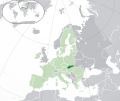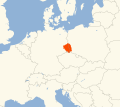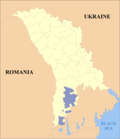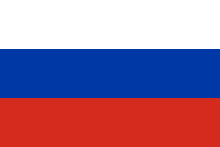Pan-Slavic colors
Among the pan-Slavic colors were presented at the Prague Slav Congress in June 1848 , the Russian colors White - Blue - Red explained. Originally these colors were chosen to express the togetherness of the Slavic peoples in the sense of Pan-Slavism . The colors are used today in the flags of most states with a Slavic-speaking majority.
Idol
The model of the Pan-Slavic colors are the colors of Russia , which Tsar Peter the Great is said to have arranged in memory of his stay in the Netherlands in the form of a horizontally striped tricolor, based on the Dutch model. The Russian colors and thus other Pan-Slavic flags, however, show a violation of the heraldic color rule , according to which red and blue may not be directly next to each other, since both are so-called "colors" (in contrast to the so-called "metals") White for silver and yellow for gold).
takeover
The Serbs were the first people to expand their national flag with the color white (red, blue and white) in 1835 . One of the first Serbian flags already consisted of the colors red and blue and is documented as early as the 13th century. The Kingdom of Montenegro adopted the Pan-Slavic colors in the Serbian order (red, blue and white) without any change. In 1867 the Slovenes adopted the colors white, blue and red in the originally Russian order. They were followed by the Slovaks and the Czechs .
From 1848 the Croatians also adopted a red-white-blue flag with Pan-Slavic intentions , which, according to a more modern Croatian interpretation, shows the colors of Croatia , Dalmatia and Slavonia , but not the Pan-Slavic colors. Croatian authors even use sources from the time of Austro-Hungarian foreign rule for this interpretation.
The Bulgarian flag was also created as a symbol of Pan-Slavic thought and consciously based on the white-blue-red flag of Russia, but the blue was replaced by green.
use
National flags
| region | location | flag | Remarks |
|---|---|---|---|
| Russia |

|

|
The flag of Russia followed the example of the flag of the Netherlands , but the colors were also used in the coat of arms of the Principality of Moscow : on a red background, a white knight rides a white horse, wrapped in a blue coat and wearing a blue shield. |
| Serbia |

|

|
The flag of Serbia has the small coat of arms of Serbia centered vertically and horizontally 5/14 of the flag width from the side of the flagpole (left). |
| Croatia |

|

|
For the flag of Croatia , the Pan-Slavic colors were combined with the colors red and white from the time of the Austro-Hungarian foreign rule. According to more modern Croatian interpretations, blue, white and red represent the Croatian parts of the country. |
| Slovakia |

|

|
The original flag of Slovakia in the Middle Ages consisted of two stripes, red and white (red on top). After the creation of Czechoslovakia in 1920, after long deliberation, the traditional Bohemian white and red flag was supplemented by a blue triangle, which was supposed to symbolize Slovakia, as the Slovaks had had a blue stripe in their flag since 1848. |
| Slovenia |

|

|
The coat of arms in the flag of Slovenia consists of a blue shield with a red border on the two lower sides. The sign shows two waves, which symbolize the Adriatic Sea (Jadransko morje), the three-pointed peak of Triglav (Slovenia's highest mountain) and the three gold-colored stars from the coat of arms of the Counts of Cilli (Celje). |
| Sorbs |

|

|
A Sorbian flag was first mentioned in 1842. After the Pan-Slavic Congress that took place in Prague in 1848, it was given its current color scheme. It is based closely on the flags of Russia and Serbia, but also on those of the neighboring Slavic peoples, the Czechs and Slovaks. |
| Czech Republic |

|
 |
A blue equilateral triangle for Slovakia (see flag of Slovakia) was inserted into the flag of the Czech Republic in 1920 on the left edge of the flag, so that the flag was now held in the Pan-Slavic colors white-blue-red. The white, red and blue tricolor has also been an official national symbol of the Czech Republic since 1993. |
Flags of autonomous regions
| region | location | flag | Remarks |
|---|---|---|---|
| Chukchi Autonomous Okrug |

|

|
The Chukchi Autonomous Okrug uses the Russian flag in its emblem, although the Chukchi are not Slavic. |
| Khakassia |

|

|
The Khakass are not a Slavic people, but are counted among the Turkic peoples . |
| Gagauzia |

|

|
The flag of Gagauzia initially did not contain any stars. Gagauz are a Turkic people, not Slavs. |
| Carpathian Ukraine |

|

|
The flag of Carpathian Ukraine should not be confused with that of Zakarpattia Oblast . |
| Crimea |

|

|
The flag of the Autonomous Republic of Crimea is based on the flag of Russia. The original proposal still had an emblem. |
| Mordovia |

|

|
The Mordvins are not a Slavic, but a Finno-Ugric people. |
| Perm region |

|

|
The Perm Region emerged from the Perm Oblast and the Komi-Permyak Autonomous Okrug . |
| Republika Srpska |

|

|
The flag of the Republika Srpska is based on the flag of Serbia. In contrast to the flag of Serbia, however, it is not officially used with additional symbols such as the double-headed eagle. In addition, the colors differ slightly and the aspect ratio, like the flags in the former Socialist Federal Republic of Yugoslavia, is 1: 2 and not 2: 3, as in Serbia. |
| Vojvodina |

|

|
The flag of the Serbian province Vojvodina is based on the flag of Serbia . |
Historical flags
Flag of the Federal Republic of Yugoslavia and the Confederation of Serbia and Montenegro
Montenegro within the Federal Republic of Yugoslavia and the confederation of Serbia and Montenegro
Independent State of Montenegro (1941–44).
See also
Individual evidence
- ^ Karl-Heinz Hesmer: Flags and coats of arms of the world , page 88.Bertelsmann Lexikon Verlag Gütersloh 1992
- ↑ Mario Jareb: Hrvatski nacionalni simboli [Croatian National Symbols] . ALFA dd Hrvatski institut za povijest, Zagreb 2010, ISBN 978-953-297-230-6 , Nastanak suvremene hrvatske nacionalne zastave, p. 55 ff .
- ^ Republic of Croatia (Socialist Yugoslavia): Flag of Socialist Croatia , Flags of the World (English).
- ^ Reichsrat, House of Representatives (ed.): Appendix to the stenographic minutes of the House of Representatives of the Austrian Reichsrat . Staatsdruckerei, 1907, p. 984 : "[...] after the following provision is contained in § 63 of the Hungarian-Croatian settlement :" [...] in addition to the Hungarian flag, the united Croatian-Slavonian-Dalmatian flag (namely the red-white-blue) flag [...] ""
- ^ Karl-Heinz Hesmer: Flags and coats of arms of the world , page 36.Bertelsmann Lexikon Verlag Gütersloh 1992












